Apples for 2024
Most apples require another apple or crabapple variety to produce fruit. See chart at the end of document for more information.
Anna: Very early blooming, early ripening and very productive. A Golden Delicious type great for fresh eating or cooking. Sweet, spicy, unusual flavor in a beautifully blushed fruit. Considered partially self-fertile but better with a pollinizer. M7 rootstock.
Beni Shogun Fuji: Hailing from Japan, this variety is scab and mildew resistant making it a wonderful choice for organic growers. The fruit is medium-large, has orange-red skin, crisp texture, and juicy sweet flavor and a distinctive aroma. While Fujis are considered late to ripen, this variety is the earliest in the group, ready for harvest in mid-September. It is excellent for eating, cider, and stores well. M106 rootstock.
Braeburn: Developed in New Zealand in the 1950s, the Braeburn is considered a “dessert” apple: juicy with a crisp texture, and a flavor described as sharp and refreshing, sweet without being sugary. The skin is washed in shades of red and green – it was one of the first bi-colored varieties created! A WSU Mt. Vernon recommended variety for the Puget Sound. Matures late, keeps well. M106 rootstock.
Chehalis: This old favorite was discovered north of Chehalis, WA in 1937. This is a large, sweet yellow apple that resembles Golden Delicious in looks and flavor, but it is crisper and larger. This reliable, highly productive tree is suited for organic growers; it is highly resistant to scab and has good mildew resistance. Fruit ripens in mid/late September. Great for fresh eating, and saucing. M106 rootstock.
Cosmic Crisp: Developed by Washington State University and released in 2019, this apple is suited to the PNW. Mid to late season bloom, ripens in early October. The flavor is exceptional, both sweet and tart, making it an excellent apple for fresh eating. It is slow to brown once cut, has a long storage life, and holds its flavor well. Red in color with yellow flecks on the skin. M26 rootstock. Not pollinized by Honeycrisp or Enterprise.
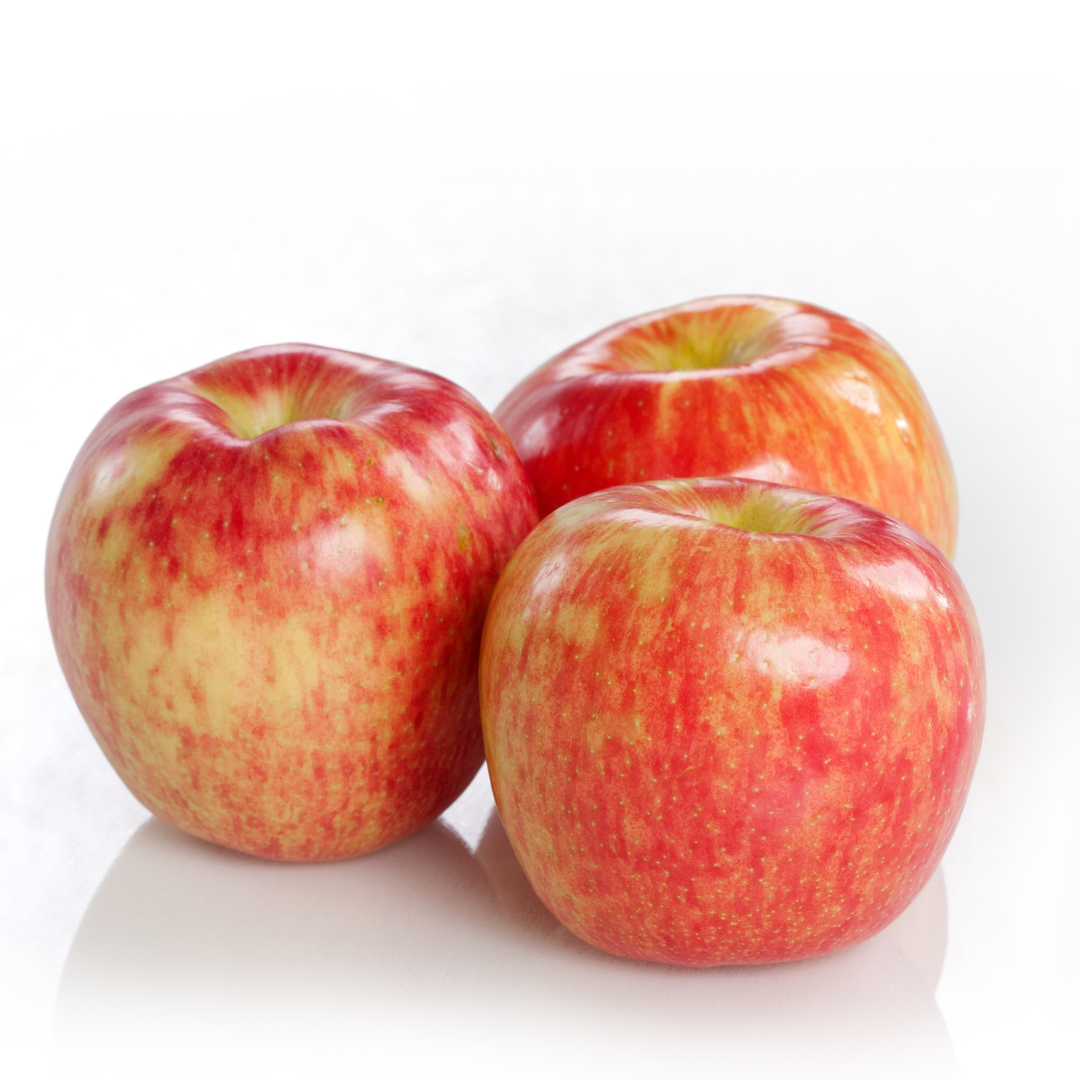
Enterprise: This versatile apple started out in 1982 as a seedling and was released to market in 1993.This deep maroon apple is mildly tart and spicy, it is good for eating right off the tree, its flavor improves after storage and can be stored for up to six months. Apple scab immune and resistant to fireblight. Ripens in early October; holds well on the tree. M106 rootstock.
Gala: The most popular apple in the world, a cross between Golden Delicious and Kidd’s Orange Red. This apple has pale golden yellow skin covered by a stripy red blush; flesh is juicy and sweet with hints of vanilla and a floral aroma. This is a great multi-purpose apple suited for fresh eating, juicing and cooking, but not for storing. Late blooming, early to ripen. Mildew resistant. M106 rootstock.
Gravenstein: This nostalgic cultivar was the primary variety used during WWII to make apple sauce and dried apples to feed the troops. The skin is a delicate waxy yellow-green with crimson spots and reddish lines. The flesh is juicy, finely grained, and light yellow. One of the best cooking apples but sadly not suited for storage, which is why it is seldom found in markets. An early to mid-season bloomer, one of the first apples to ripen. This is a triploid variety which means it is a poor pollinator of other apples. Semi-dwarf rootstock.
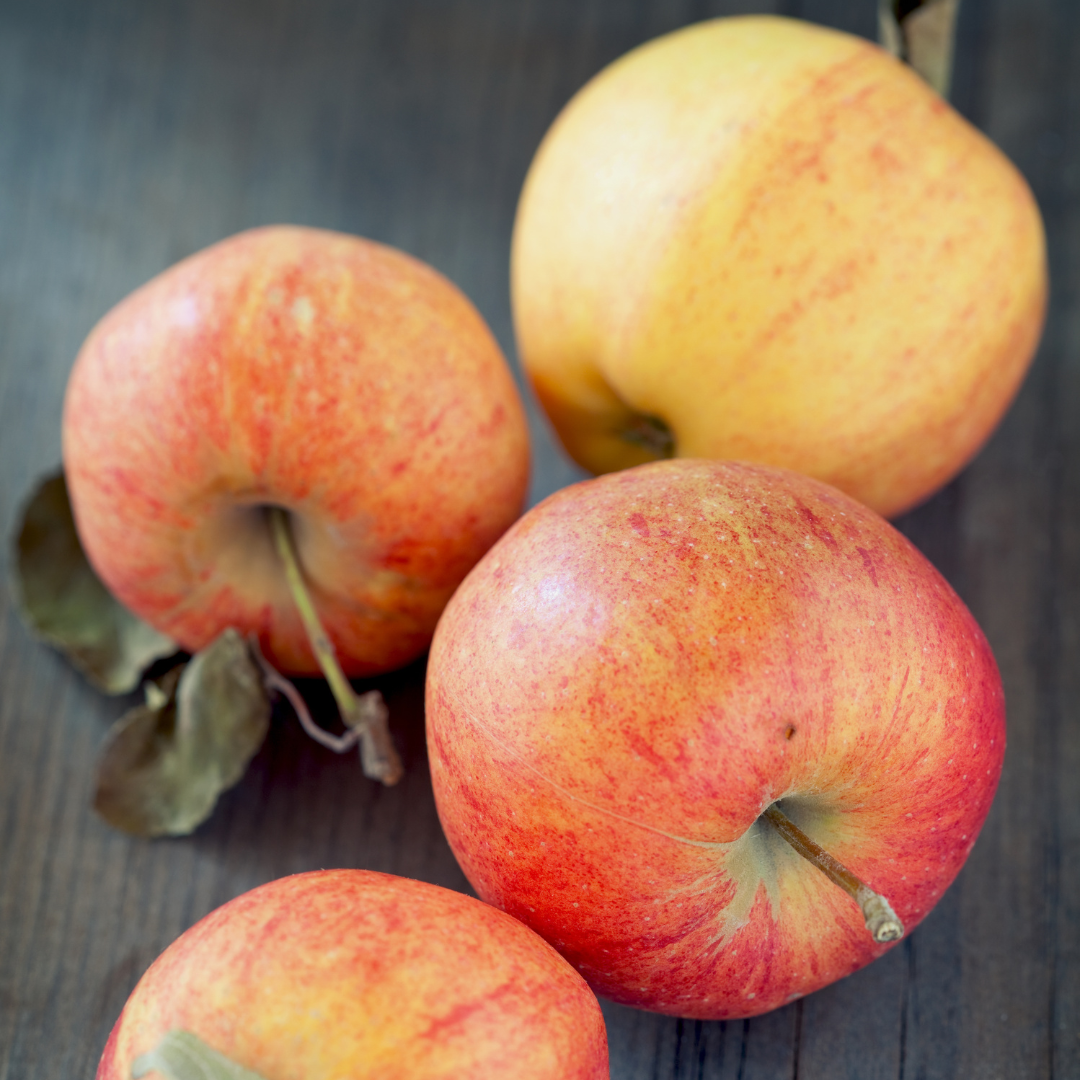
Honeycrisp: A modern apple with perhaps the best eating qualities in history. Medium to large red blushed with yellow apples are highly aromatic. Explosively crisp, sweet and juicy, yet with some tartness. Excellent for fresh eating, cooking, storing and juicing! Fruit ripens in late September but becomes more flavorful if left on the tree into October. Good disease resistance. A WSU Mt. Vernon recommended variety. Available on either M106 or Geneva 969 rootstock. Not pollinized by Cosmic Crisp.
King: This historic variety has been known since 1804. Large fruits are waxy yellow-green with red striping, flesh is crisp and sweet. They are excellent for fresh eating, cider and cooking. Will keep 2-3 months. Bears mid-to-late Oct. This highly prized apple is a tip bearer: wait to prune until two inches of new growth has begun in spring. Then prune back to 6-8′ of last years’ growth! This variety is triploid, and will not pollinize other varieties.
Liberty: One of the easiest apples to grow, this variety should be included in all Whidbey orchards. It produces a bounty of medium sized, shiny red aromatic apples with yellow overtones. The very juicy fruit has crisp white flesh and a sweet, crunchy texture. Good for fresh eating, baking and ciders. Ripens in late September and stores well. Very disease resistant. The tree tends to over-produce; thinning produces better quality fruit. A WSU Mt. Vernon recommended variety. M106 rootstock.
Lucy Rose: A golden apple with – surprise! – striking rose-colored flesh inside and a distinctly strawberry-like flavor. M106 rootstock. Not pollinized by Honeycrisp (a parent).
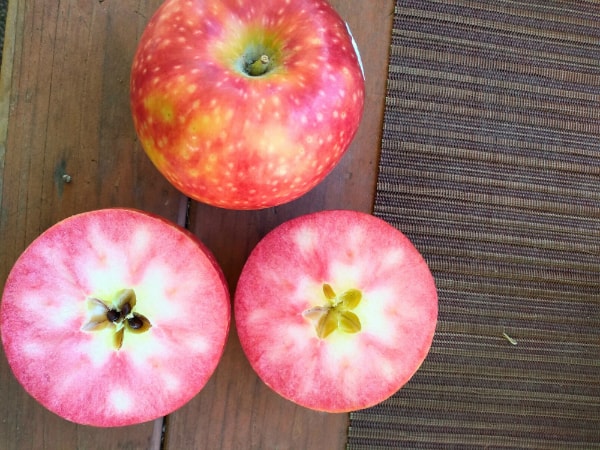
Melrose: A cross between Johnathon and Red Delicious, the fruits are large & flattened like Jonathan, with skin that is streaked and flushed with dark red over a background of yellowish-green skin, with spots of russet. The flesh is creamy white, firm, coarse-textured, and juicy. The flavor is mildly acidic, similar to Jonathan, but not as tart. It is top-rated for reliability and productivity. Often used for baking, Melrose is a great keeper apple whose flavor often improves with storage. Ripens in October Semi dwarf.
Mutsu: Also known as Crispin. Sweet, honeyed flavor – good for eating, baking, and cider! Cross between Golden Delicious and Indo. Its large fruit is green/yellow. Highly resistant to frost injury. Ripens end of September. Some disease susceptibility, does not pollinate other trees, tends toward biennial production. This variety is pollen sterile and will not pollinize other varieties.
North Pole: This is a space-friendly apple; the columnar form is suited for any small garden, patio, or even a large pot! This is a red apple in the Macintosh group, so expect a juicy, sweet-tart flavor. You can keep this tree to 2-3’ wide by 6-8’ tall. M7 rootstock.
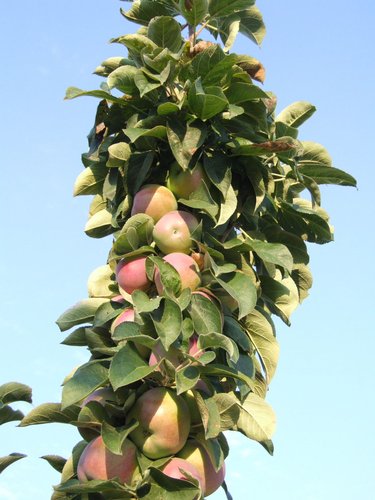
Pink Pearl: Flavorful, aromatic yellow apple with bright pink flesh! Use it to make a beautiful pink applesauce or to add color to fruit salads. This apple is worth growing, even though it has some susceptibility to scab. Ripens in late September. M106 rootstock.
Pristine: medium size yellow fruit, crisp and mildly tart. Ripens in August. Great for fresh eating, saucing, and baking. Good disease resistance. A WSU recommended variety. M106 rootstock.
Scarlet Sentinel: This is a space-friendly apple; the columnar form is suited for any small garden, patio, or even a large pot! This is a Macintosh type apple so expect that crisp snappy taste! M7 rootstock.
Sunrise Magic: Developed by WSU, this is a cross between Splendor and Gala. Pinkish-red blush over a yellow background, fruit is firm, crisp and juicy with a bright sweet flavor. Great fresh off the tree and stores well too. Ripens late Sept/early Oct. M26 rootstock.
Winter Banana: This heirloom variety, hailing from Indiana circa 1876, is a beautiful apple with a waxy yellow skin delicately blushed pink when ripe. The flesh is tender and has a subtle, tropical-fruit flavor best-suited for fresh eating. A tree full of ripe fruit can give off the scent of bananas. The low chill requirements make this apple well-suited for west-coast gardens. It is one of the few self-fertile apples, but it will produce more reliably with another pollinizer. M111 rootstock.
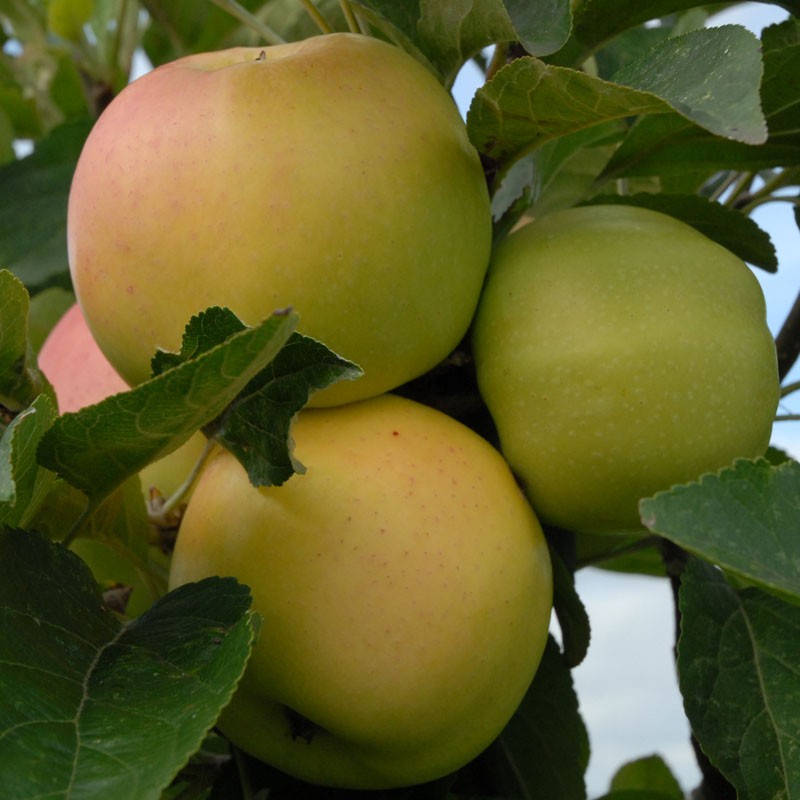
Espalier: A tiered fruit tree with 3 different kinds of apple varieties grafted to one root stock, ensured to pollinate each other.
Espalier 2: Gala, Honeycrisp, Fuji (on M26 rootstock)
Espalier 3: Akane, Honeycrisp, Liberty (on M26 rootstock)
Apple Pollination Guide
In general, all apples need to be cross-pollinated by another apple that flowers at the same time. The safest is to choose another variety in bloom at the same time, but typically there is adequate overlap between each neighboring bloom category. For example, Braeburn is a mid-season apple, so while the safest is to choose another cultivar from the mid-season category, it is likely that a type from the early-mid or late season could also be used.
Varieties in *bold are pollen-sterile or triploid and cannot be used as pollinizers.
Certain apples will not be pollinized by cultivars that are in their parentage. For example, Cosmic Crisp is a cross of Enterprise x Honeycrisp so neither will work as a pollinizer.
Any apple in italics is a variety we have sold in the past but are not stocking this year.
| Early | Early-Mid | Mid | Late |
| Anna | Akane | Braeburn | Beni Shogun |
| *Gravenstein | Early Pink Lady | Chehalis | Cosmic Crisp |
| McIntosh | Empire | Enterprise | Gala |
| Pink Pearl | Liberty | Jonamac | Golden Raindrops Crabapple |
| Zestar | McIntosh | *Jonagold | Granny Smith |
| North Pole | Lucy Rose | Honeycrisp | |
| Pristine | Melrose | *King | |
| Scarlet Sentinel | *Mutsu | Spartan | |
| Yellow Transparent | Thunderchild Crabapple | ||
| Sunrise Magic | |||
| Winter Banana |
Apple Rootstock Guide
M106 (EMLA106): Semidwarf, typically 10’ – 13’ tall; tolerant of many soil types except for very wet soils; early production.
Geneva 969: Semidwarf, 50% of standard size so typically 12’ – 15’ tall. High resistance to Wooly Apple aphids and fireblight. Medium resistance to Crown and Root rot. Precocious and productive. Provide adequate drainage.
M7(EMLA7): Semidwarf, unpruned tree height 2/3 of standard, or about 12-20 ft. Induces early and heavy bearing, resists fire blight and powdery mildew. Moderately resistant to collar rot. Good anchorage. Very winter hardy. Trees on M-7 may be held to any desired height by summer pruning.
M26 (EMLA26): Vigorous dwarf, about 40 to 45 percent of a standard tree. Needs some support in early years, but could be self-supporting in later years. Very early and heavy bearing. Adaptable for close plantings and double rows.
M111 (EMLA111): Dwarf; Unpruned tree height 80-90% of standard. Excellent all-around rootstock for apples. Tolerates wet, dry, or poor soil. Resists woolly apple aphids and collar rot. Induces bearing at young age. Trees on M-111 may be held to any desired height by summer pruning.
